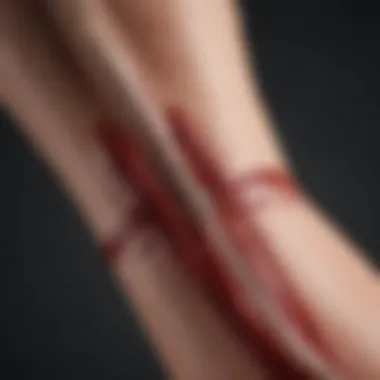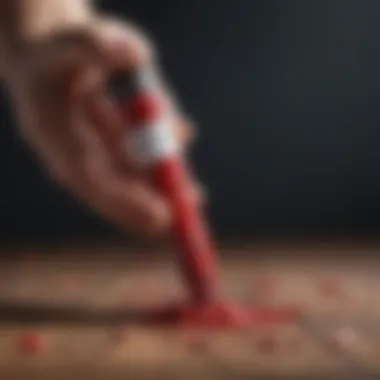Understanding Blood Stop Sticks: Applications and Benefits


Intro
Blood stop sticks, while not a household name, play a critical role in medical and therapeutic settings. Understanding their applications, benefits, and implications can provide valuable information, especially for health professionals, wellness coaches, and others in the health industry. These tools are designed to effectively manage bleeding, promoting safety and well-being in various contexts.
Emerging from the need for quick and efficient solutions to bleeding control, blood stop sticks enable timely interventions. They are not only relevant for trauma care but also for various medical procedures. The increasing interest in these tools highlights a shift toward improved patient outcomes and innovative health strategies. This highlights the importance of staying updated on recent findings and changes in practices surrounding their use.
Foreword to Blood Stop Sticks
The development and utilization of blood stop sticks represent a significant advancement in the management of bleeding during various medical procedures. This section aims to provide an essential understanding of the topic—blood stop sticks—highlighting their definition and historical significance. These tools have proved invaluable in both emergency and surgical settings, reducing mortality and morbidity associated with uncontrolled bleeding. As healthcare continues to evolve, recognizing these tools' applications and benefits becomes increasingly crucial.
Definition and Overview
Blood stop sticks are specialized medical devices designed to facilitate hemostasis, the process of stopping bleeding. They work by promoting blood clotting, either mechanically or chemically. Traditionally, these sticks contain components that aid in the clotting process, ensuring that blood loss is minimized during critical situations. These tools are often made from materials such as cellulose or other biocompatible substances, which can effectively interact with blood components to enhance coagulation. In recent times, advancements have led to blood stop sticks being integrated with innovative technologies, improving their efficiency and ease of use in clinical practice.
Historical Context
The concept of stopping bleeding is not new; ancient cultures employed various methods, from applying pressure to using herbal substances. However, the formal development of blood stop sticks began in the late 20th century. Initially, these devices emerged as simple gauze tools soaked with hemostatic components. As research progressed, there was a transition to more sophisticated products, incorporating not just gauze but also advanced materials such as chitosan and cellulose. The 21st century marks a pivotal point where blood stop sticks have advanced with technology, leading to more effective solutions for managing severe hemorrhage in both civilian and military medical fields. Today, these devices play a crucial role in trauma care, surgeries, and emergency medicine, continually evolving to address the various challenges presented in bleeding management.
"The evolution of blood stop sticks embodies the intersection of traditional practices and modern science, providing a powerful tool in saving lives."
The Mechanism of Action
Understanding the mechanism of action of blood stop sticks is crucial for appreciating how these medical tools can be efficacious in controlling bleeding. This section delves into both the operational principles and the chemical nature of blood stop sticks, shedding light on their design and functionality in various clinical scenarios.
How Blood Stop Sticks Work
Blood stop sticks utilize a straightforward yet effective mechanism to control hemorrhage. When applied to a bleeding wound, they create a physical barrier that aids in clot formation. This process is facilitated by the interaction of the stick’s materials with blood components. The surface area of the blood stop stick encourages platelet adhesion, which is essential for clot formation. Moreover, the pressure applied while placing the stick can help to compress the blood vessels, slowing down the bleeding further.
- Step-by-step process:This mechanism is critical in emergency situations where rapid intervention is needed. The effectiveness of blood stop sticks in promoting hemostasis makes them valuable tools in hospitals and first aid kits alike.
- Application: The blood stop stick is pressed against the site of bleeding.
- Adhesion: Blood components adhere to the stick, initiating the clotting process.
- Compression: The stick adds pressure to the wound, decreasing blood flow.
- Clot formation: With time, a stable clot begins to form, limiting blood loss.
Chemical Composition
The chemical composition of blood stop sticks can vary, but their effectiveness stems from specific biological and synthetic materials. Understanding these materials can help health practitioners choose the right type of blood stop stick for various situations. Common compositions might include:
- Natural polymers: Substances like alginate and chitosan, which promote healing and clotting.
- Synthetic agents: Materials such as polyethylene glycol that enhance the physical properties of the sticks.
- Bioactive components: These may include growth factors or clotting agents that facilitate the hemostatic process.
A thorough understanding of these components can impact patient outcomes. Certain compositions may be more suitable for specific types of wounds or patient conditions, leading to tailored care in clinical settings.
As blood stop sticks continue to evolve, ongoing research into their chemical and biological properties will likely lead to enhanced efficacy and safety.
“The choice of material in blood stop sticks directly affects their performance in real-world medical scenarios.”


In summary, the mechanisms that underpin the functionality of blood stop sticks provide essential insights into their application and effectiveness in controlling bleeding. This understanding equips health professionals with the necessary knowledge to employ these instruments effectively in their practice.
Clinical Applications
The clinical applications of blood stop sticks are integral to understanding their role in modern medicine. These devices are designed specifically to control bleeding and promote hemostasis in various medical settings. Their versatility allows them to be employed in emergency situations, surgical procedures, and therapeutic scenarios. Conditions such as trauma, surgery-related bleeding, and chronic wounds may benefit from the effective application of blood stop sticks.
Emergency Medicine
In emergency medicine, blood stop sticks have become a critical tool for first responders and hospital staff alike. The ability to stop bleeding quickly can mean the difference between life and death. The application of blood stop sticks allows for fast intervention in traumatic injuries, such as those sustained in car accidents or severe falls. When a patient presents with a hemorrhage, timely use of these devices can stabilize their condition before further medical treatments are administered. Additionally, the ease of application permits responders to focus on relocating the patient or addressing other urgent matters.
Surgical Use Cases
During surgery, precision and control over bleeding are paramount. Blood stop sticks assist surgeons in achieving hemostasis, particularly in vascular surgery or orthopedic procedures where blood loss can be significant. The use of these devices minimizes the need for cauterization or extensive suturing, leading to less tissue damage and lower risk of complications. Moreover, by effectively controlling bleeding, surgical teams can concentrate on the operative field without distraction. This directly translates to a reduced duration of surgery and enhanced recovery times for patients.
Therapeutic Contexts
In therapeutic contexts, blood stop sticks can provide substantial aid during various treatment procedures. For example, they may be used in dermatological treatments, such as mole removal or skin grafting, where precise control of bleeding is crucial for optimal results. These devices also enhance safety protocols during injections or intravenous therapies. By reducing patient anxiety around potential bleeding during treatment, health professionals can improve overall patient experience.
"The efficacy of blood stop sticks extends beyond emergency and surgical applications. Their role in therapeutic settings allows healthcare providers to manage bleeding effectively, enhancing patient outcomes."
The continued integration of blood stop sticks in these varied clinical applications underlines their importance in improving health outcomes, reducing complications, and increasing overall effectiveness in patient care.
Benefits of Using Blood Stop Sticks
Blood stop sticks have shown considerable promise in improving patient care within varied medical practices. Understanding their benefits is crucial for health practitioners. These tools facilitate quicker management of bleeding, contributing to overall better health outcomes. Key benefits associated with the use of blood stop sticks include enhanced patient outcomes, notable reduction in complications, and significant cost-effectiveness.
Improved Patient Outcomes
One of the primary benefits of blood stop sticks is their ability to stabilize patients more effectively during emergency situations. Rapid intervention can significantly reduce the severity of blood loss. This means paramedics can administer treatment before reaching a hospital, allowing for quicker recovery post-surgery or during trauma care.
Additionally, blood stop sticks often lead to better adherence to blood control protocols. This contributes positively to patient prognosis. Patients receiving timely intervention generally report fewer instances of prolonged recovery or additional medical interventions. Therefore, the overall quality of care is elevated, showing a direct correlation between prompt stick application and positive recovery trajectories.
Reduction in Complications
Another significant advantage of blood stop sticks is their role in minimizing complications associated with bleeding. In many medical emergencies, uncontrolled bleeding can lead to serious conditions such as shock. Blood stop sticks provide an effective means to immediately address this risk. Their application can create a pressure effect on the wound, which not only controls blood flow but also aids in forming a clot.
Moreover, the efficient use of these tools can result in a reduction of secondary infections that could arise from open wounds. Cleaner and more controlled bleeding sites decrease the likelihood of pathogens entering the bloodstream, leading to lower infection rates. Inevitably, this means less need for antibiotics and a smaller chance of sepsis.
Cost-Effectiveness
Finally, the cost-effectiveness of blood stop sticks is a noteworthy point for consideration. In healthcare, the allocation of resources must be strategic. Blood stop sticks can greatly reduce costs associated with prolonged hospital stays and extensive treatments due to complications from blood loss. Their use can lead to a more streamlined approach in managing emergencies and surgeries, ultimately saving hospitals money in the long run.
“Implementing blood stop sticks not only enhances immediate care but can also be a financial relief for healthcare systems.”
In summation, the advantages of blood stop sticks extend beyond immediate patient care. Improved outcomes, reduced complications, and cost-effectiveness make these tools indispensable in the healthcare toolkit. Practitioners should thus be well-informed on their use to maximize these benefits.


Training and Best Practices
Understanding proper training techniques and best practices for the use of blood stop sticks is crucial for health professionals. This ensures improved outcomes for patients and optimal effectiveness of the tools. The correct application can greatly enhance the efficacy of blood stop sticks in both emergency and surgical contexts. In addition, knowledge in this area can prevent potential complications arising from misuse or insufficient technique.
Proper Use Techniques
Proper use techniques are fundamental for achieving the desired effects when applying blood stop sticks. Here are specific steps health professionals should follow:
- Preparation: Ensure that the area surrounding the injury is clean. Wash the hands to minimize contamination risks.
- Application: Apply the blood stop stick directly on the wound. It should be pressed firmly to ensure adequate contact with the tissue.
- Timing: Monitor the application time. Typically, the stick should remain in place for several minutes until bleeding is controlled.
- Observation: After use, observe the wound for any signs of continued bleeding or infection.
Proper training in these techniques can help prevent misuse, which may lead to inadequate hemostatic effects. Additionally, awareness of different types of injuries can guide professionals in selecting the right blood stop product.
Common Mistakes to Avoid
Even with the best intentions, mistakes can occur. Here are crucial pitfalls to avoid:
- Insufficient Pressure: Not applying enough pressure can result in ineffective bleeding control. Make sure to apply firm pressure to maximize occlusion.
- Ignoring Instructions: Each blood stop stick product may have unique instructions. Following the manufacturer's guidelines is essential for optimal results.
- Failure to Monitor: After using a blood stop stick, neglecting to monitor the wound may lead to serious complications. Regular checks can identify issues early.
- Poor Training: Lack of training or understanding of the product can lead to errors. Continuous education and practical training sessions should be encouraged among health practitioners.
Proper training and knowledge significantly influence the effectiveness of blood stop sticks and enhance patient care.
By focusing on proper techniques and learning from common mistakes, health professionals can improve their skills in applying blood stop sticks and ensure the safety and well-being of their patients. These best practices help create a solid foundation for clinical application and can contribute to greater confidence in emergency settings.
Potential Risks and Limitations
The discussion of blood stop sticks extends beyond their benefits and applications. It is crucial to address the potential risks and limitations associated with their use. Understanding these elements helps health professionals make informed decisions and provides depth to the discourse surrounding these tools. Blood stop sticks can be invaluable, yet they can pose certain challenges that require careful consideration.
Possible Adverse Effects
Despite their designed purpose, blood stop sticks may cause adverse effects in some cases. The following points outline these potential negative outcomes:
- Tissue Reaction: Some patients might experience irritation or allergic reactions to the materials used in blood stop sticks. This can lead to localized inflammation or discomfort.
- Infection Risk: Improper use or application of blood stop sticks may increase the risk of infection, particularly if the skin is compromised.
- Incomplete Hemostasis: If the blood stop stick is not applied correctly, it may fail to achieve complete hemostasis, leading to continued bleeding.
- Incorrect Removal: Removing the stick prematurely can lead to renewed bleeding. This can disrupt the healing process and result in complications.
It is essential for practitioners to remain vigilant regarding these possible adverse effects. A thorough understanding of the potential impact on patient outcomes helps to mitigate risks.
Patient Considerations
When considering the application of blood stop sticks, several patient factors should be evaluated. Addressing these considerations ensures that treatment aligns with individual patient needs and circumstances.
- Patient History: A comprehensive medical history is vital. Prior allergic reactions or underlying conditions can influence the suitability of the blood stop stick.
- Current Medications: Certain medications may affect blood clotting and influence the effectiveness of blood stop sticks. Patients on anticoagulants may require specialized attention.
- Wound Characteristics: The nature of the wound, such as its location and severity, will determine the appropriateness of using blood stop sticks.
- Patient Education: Ensuring that patients understand the purpose and potential risks associated with blood stop sticks can improve compliance and outcomes. They should be informed about when to seek further medical assistance after application.
The emphasis on understanding these patient considerations helps practitioners tailor their approach, enhancing overall treatment efficacy while minimizing risks.
"In medicine, the balance between benefits and risks must always be maintained. Acknowledging limitations leads to optimized patient care."
Research and Development


Research and development are crucial in the field of blood stop sticks. This area focuses on improving existing products and exploring new formulations. Understanding how these advancements affect clinical practices is vital for healthcare practitioners. Continuous research leads to enhanced efficacy, safety, and usability of blood stop sticks. This ensures that patients receive the best care possible.
In recent times, there has been increasing emphasis on evidence-based practices. This focus guides healthcare professionals in selecting the most effective tools and techniques. Therefore, ongoing research not only informs the development of these sticks but also solidifies their credibility in medical contexts.
Current Studies
A variety of current studies provide insights into the effectiveness of blood stop sticks. One area of investigation is the comparative analysis of different formulations. Researchers are examining how variations in composition influence clotting times and patient outcomes. Some recent studies delve into the integration of biocompatible materials that may enhance the adhesive properties of these sticks. The findings of these studies impact clinical applications, helping to optimize treatment protocols.
Moreover, researchers are exploring the impact of environmental factors on the effectiveness of blood stop sticks. Investigations into storage conditions, temperature variations, and shelf life present valuable information for practitioners. Understanding these elements can lead to better management and implementation of these products in emergency situations.
"Advancements in blood stop stick technology stem from rigorous research, ultimately improving patient care."
Future Directions
The future of blood stop sticks holds promising developments. Ongoing research aims to further refine their chemcial compositions. This could lead to enhanced hemostatic properties and reduced adverse effects. Innovation in materials could also result in improved biocompatibility. These advancements may make blood stop sticks safer for a broader range of patients.
Another significant area of exploration is the integration of advanced technologies. The application of smart technologies could enable real-time monitoring of the stick’s effectiveness. This could offer insights into how these products work in diverse situations and with varying patient needs.
Ultimately, the journey of research and development for blood stop sticks represents a commitment to advancing healthcare practices. As new studies emerge, the industry is likely to see a continuous evolution in how these tools are understood and utilized.
Case Studies
Case studies play a crucial role in understanding the practical applications of blood stop sticks. They provide real-life examples of how these tools are implemented in various medical scenarios. Through case studies, health professionals can analyze both successful outcomes and challenges faced during treatment with blood stop sticks. This knowledge serves as a valuable resource that can inform future practices and enhance patient care.
Successful Implementations
Successful implementations of blood stop sticks are vital to assess their effectiveness and reliability. One instance is a case in a busy urban hospital where emergency response teams used blood stop sticks in high-pressure situations. A patient suffering from a severe laceration received timely application of a blood stop stick. The result was a significant reduction in bleeding, which allowed for immediate transfer to surgery. Such implementations show that when properly used, blood stop sticks can mitigate risks during critical moments.
In another study, surgical teams in a regional hospital integrated blood stop sticks into their post-operative care protocols. This led to decreased recovery times and lower incidence of complications related to bleeding. Health practitioners noted improved overall patient satisfaction, indicating that patients felt safer and more secure during their recovery process. These successful applications not only demonstrate the effectiveness of blood stop sticks but also highlight their potential for improving surgical outcomes.
Lessons Learned
Analyzing lessons from case studies involving blood stop sticks can provide insights for future use. One common lesson is the importance of training. In a particular instance, a team faced challenges due to a lack of proper training on the correct application of blood stop sticks. This oversight delayed treatment and resulted in a longer recovery process for the patient. Consequently, it highlighted the necessity for ongoing education and practice for health professionals.
Moreover, case studies have shown the need for careful patient evaluation before using blood stop sticks. Some patients may have specific conditions that make the use of these tools less effective or safe. It’s essential for practitioners to consider individual patient histories and overall contexts. Learning from past implementations can lead to better decision-making in future cases.
“Case studies reveal not just the successes, but also the network of knowledge sharing that enhances practice across the health community.”
Epilogue
The conclusion section of this article serves not only as a summary but also as a reflection on the vital role blood stop sticks play in modern medicine. These tools represent a significant advancement in the management of bleeding, enhancing patient safety and outcomes across various clinical scenarios.
Summary of Key Insights
Blood stop sticks have emerged as essential components in emergency medicine, surgical procedures, and therapeutic contexts. They offer numerous advantages, including speed and efficiency in stemming blood loss, ease of use, and accessibility. The chemical composition of these sticks ensures they can effectively interact with biological tissues to promote clotting. In the clinical applications reviewed, they demonstrate effectiveness, contributing positively to patient outcomes and reducing the likelihood of complications. Moreover, ongoing research continues to refine their application and explore new potentials, underscoring their importance in the medical field.
Implications for Future Practice
As we look towards the future, the integration of blood stop sticks within standard medical practices is likely to expand. Health professionals should remain informed about new developments as research uncovers additional benefits and improved formulations. Furthermore, training programs need to emphasize the proper techniques for the use of these tools, minimizing risks associated with improper application. By fostering a deeper understanding of blood stop sticks, practitioners can enhance their effectiveness in emergency situations, ultimately benefiting patient care.
"Continued research and training are essential for maximizing the benefits of blood stop sticks in clinical settings."



